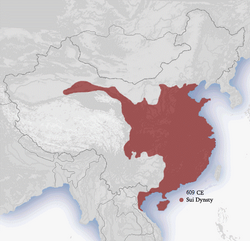Sui Dynasty
| Sui dynasty | ||||||||||||
| 隋朝 | ||||||||||||
|
||||||||||||
|
Sui dynasty circa 609 AD
|
||||||||||||
| Capital | Daxing (581–605), Luoyang (605–614) | |||||||||||
| Languages | Middle Chinese | |||||||||||
| Religion | Buddhism, Taoism, Confucianism, Chinese folk religion, Zoroastrianism | |||||||||||
| Government | Monarchy | |||||||||||
| Emperor | ||||||||||||
| • | 581–604 | Emperor Wen | ||||||||||
| • | 604–617 | Emperor Yang | ||||||||||
| • | 617–618 | Emperor Gong | ||||||||||
| History | ||||||||||||
| • | Ascension of Yang Jian | 4 March 581 | ||||||||||
| • | Abolished by Li Yuan | 23 May 618 | ||||||||||
| Area | ||||||||||||
| • | 589 est. | 3,000,000 km² (1,158,306 sq mi) | ||||||||||
| Population | ||||||||||||
| • | 609 est. | est. 46,019,956 | ||||||||||
| Currency | Chinese coin, Chinese cash | |||||||||||
|
||||||||||||
| Today part of |
|
|||||||||||
| Sui dynasty | |||||||||||||||||||||||||||||||

"Sui dynasty" in Chinese characters
|
|||||||||||||||||||||||||||||||
| Chinese | 隋朝 | ||||||||||||||||||||||||||||||
|---|---|---|---|---|---|---|---|---|---|---|---|---|---|---|---|---|---|---|---|---|---|---|---|---|---|---|---|---|---|---|---|
|
|||||||||||||||||||||||||||||||
| Transcriptions | |
|---|---|
| Standard Mandarin | |
| Hanyu Pinyin | Suí cháo |
| Gwoyeu Romatzyh | Swei chaur |
| Wade–Giles | Sui2 ch'ao2 |
| IPA | [su̯ěi̯ ʈʂʰǎu̯] |
| Wu | |
| Romanization | Zoe zau |
| Yue: Cantonese | |
| Yale Romanization | Chèuih chìuh |
| Jyutping | Ceoi4 ciu4 |
| Southern Min | |
| Tâi-lô | Suî-tiâo |
| Middle Chinese | |
| Middle Chinese | dwá ɖjew |
The Sui Dynasty (Chinese: ; pinyin: Suí cháo) was a short-lived imperial dynasty of China of pivotal significance. The Sui unified the Northern and Southern dynasties and reinstalled the rule of ethnic Han Chinese in the entire China proper, along with sinicization of former nomadic ethnic minorities within its territory. It was succeeded by the Tang dynasty, which largely inherited its foundation.
Founded by Emperor Wen of Sui, the Sui dynasty capital was Chang'an (which was renamed Daxing, 581–605) and later Luoyang (605–614). Emperors Wen and Yang undertook various centralized reforms, most notably the equal-field system, intended to reduce economic inequality and improve agricultural productivity; the institution of the Three Departments and Six Ministries system; and the standardization and re-unification of the coinage. They also spread and encouraged Buddhism throughout the empire. By the middle of the dynasty, the newly unified empire entered a golden age of prosperity with vast agricultural surplus that supported rapid population growth.
A lasting legacy of the Sui dynasty was the Grand Canal. With the eastern capital Luoyang at the center of the network, it linked the west-lying capital Chang'an to the economic and agricultural centers of the east towards Hangzhou, and to the northern border near modern Beijing. While the pressing initial motives were for shipment of grains to the capital, and for transporting troops and military logistics, the reliable inland shipment links would facilitate domestic trades, flow of people and cultural exchange for centuries, Along with the extension of the Great Wall, and the construction of the eastern capital city of Luoyang, these mega projects, led by an efficient centralized bureaucracy, would amass millions of conscripted workers from the large population base, at heavy cost of human lives.
...
Wikipedia

